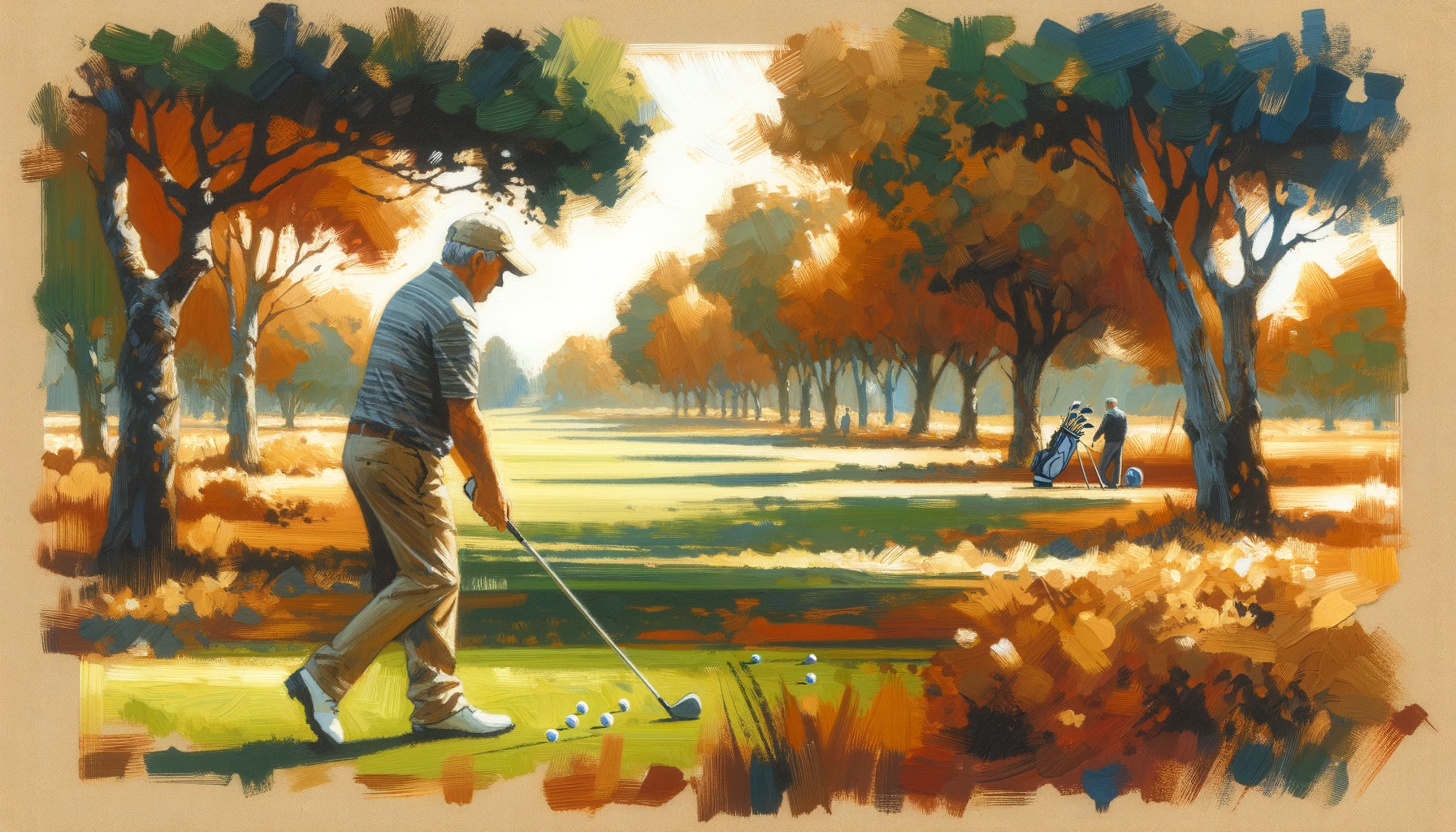- Home
- Golf Training
- Upper Body Strength for Golfers
Unlocking the Power of Upper-Body Strength for Golfers: Your Guide to a Better Game
Looking to elevate your golf game? The secret lies in your upper-body strength. This comprehensive guide reveals how targeted exercises can transform your swing, drive longer distances, and lower your scores. Whether you're a weekend golfer or aspiring pro, understanding the pivotal role of upper-body strength will change the way you approach your game. Dive into our key takeaways and FAQs for quick insights, ensuring you're equipped with the knowledge to hit the course with confidence and precision.
As a golfer who lives by the Golfeaser Manifesto, I've always been on the lookout for that edge, that one secret that could transform my game from the first tee to the 18th hole. The quest for improvement led me to a crucial realization – the significant role of upper-body strength in golf performance. It's not just about wielding the club; it's about controlling it, powering through your swing, and ensuring that every drive is as explosive as possible. But here's the problem: most golfers, especially us weekend warriors, often overlook the importance of upper-body strength, focusing instead on technique alone.
This oversight can lead to frustration on the course. Despite the latest equipment and countless hours spent analyzing swings, something is missing. The drives aren't as long as they could be, and control feels just out of reach. It's like being on the cusp of a breakthrough, yet something crucial is holding you back. This is where the agitation sets in. You've tried everything, from new clubs to instructional videos, yet the promised improvement remains elusive. The dream of consistently hitting long, towering, straight tee shots seems more like a fantasy than an achievable reality.
But here's the good news: there's a solution, and it's more accessible than you might think. Upper-body strength is the key to unlocking a new level of golfing performance. By focusing on building strength in your shoulders, chest, back, and arms, you can gain the power and control needed to elevate your game.
This article is your comprehensive guide to understanding how upper-body strength directly impacts your golf performance, identifying the best exercises to build that strength, and determining the optimal training frequency for sustainable results. Together, we'll embark on a journey to transform your game, tapping into insider information and leveraging upper-body strength for golfers to achieve those jaw-dropping drives and earn the bragging rights you've been dreaming of.
 A serene swing: The power of upper-body strength for golfers.
A serene swing: The power of upper-body strength for golfers.How Does Upper-Body Strength Improve Golf Performance?
In my journey to lower my scores and dominate the golf course, I stumbled upon a game-changing insight: the profound impact of upper-body strength on golf performance. It was a sunny afternoon on the local course, where my drives were consistently falling short. Frustrated and determined, I sought the advice of a seasoned pro who shared a secret that felt like discovering a treasure map – the link between upper-body strength and explosive drives.
Upper-body strength, encompassing the shoulders, chest, back, and arms, serves as the engine of your golf swing. It's the powerhouse that determines the velocity and stability of your club as it whizzes through the air. Here's how it breaks down:
- Shoulder Strength: Vital for maintaining a wide arc in your swing, allowing for maximum speed at impact.
- Chest and Back Muscles: These muscles contribute to the 'coil' and 'uncoil' motion during your swing, adding to the force generated.
- Arm and Forearm Strength: Essential for grip stability and control, ensuring you can direct that force precisely where you want it.
Incorporating upper-body strength exercises into my routine, I began to see changes. I added resistance training, focusing on these key areas, and complemented it with flexibility exercises to maintain a fluid motion. The results? My drives gained yardage, my control improved, and those humiliating first-tee jitters started to fade.
But don't just take my word for it. Research supports the correlation between upper-body strength and golf performance. Increased muscular strength translates to higher swing speeds and, consequently, greater ball distances. It's a no-brainer – stronger muscles mean you can apply more force to the golf ball.
To anyone seeking to elevate their game, focusing on building upper-body strength can be a game-changer. Whether it's through weightlifting, resistance bands, or body-weight exercises, strengthening the muscles responsible for your swing can transform your performance on the course. And remember, it's not just about power; it's about the control and precision that comes with it.
So, to all my fellow golfers living by the Golfeaser Manifesto, let's hit the gym with the same enthusiasm we hit the course. The path to longer drives and a lower handicap starts with strengthening our upper bodies. It's a simple change, but one that could lead to the sensational days on the course we all dream about.
Are you ready to supercharge your golf game with some muscle? Let's dive into the world of upper-body strength and watch as our drives soar farther and our scores plummet. After all, a stronger golfer is a better golfer.
 Strength in serenity: A golfer's journey to power through tranquility.
Strength in serenity: A golfer's journey to power through tranquility.What Are the Best Exercises for Building Upper-Body Strength in Golfers?
If there's one thing I've learned in my quest to conquer the golf course, it's that not all exercises are created equal, especially when it comes to golfers. During a winter off-season, determined to make a comeback that would leave my golf buddies in awe, I embarked on a mission to discover the most effective upper-body exercises for golfers. My journey led me to not only improve my game but also to share these invaluable insights with you.
Here are the top exercises that became the cornerstone of my training regime:
- Push-Ups: A staple for building strength in the chest, shoulders, and triceps, push-ups also enhance core stability, crucial for a powerful swing.
- Dumbbell Shoulder Press: Targeting the shoulders and upper back, this exercise improves the stability and power of your swing through the ball.
- Pull-Ups and Rows: These exercises strengthen the back muscles, essential for a strong, controlled golf swing and for preventing injuries.
- Rotational Medicine Ball Toss: Mimicking the golf swing, this exercise boosts rotational strength and power, key for those explosive drives down the fairway.
- Wrist Curls and Extensions: Strengthening the forearms improves grip strength, a fundamental aspect of controlling the club throughout the swing.
Integrating these exercises into my routine, I noticed a remarkable improvement not just in my drives, but in my overall control and endurance throughout the rounds. It wasn't easy; it required dedication and consistency. But as the seasons changed and I returned to the course, the results spoke for themselves. My drives were not only longer but more importantly, I was playing with confidence, backed by the strength I had built.
For anyone looking to improve their golf game, incorporating these exercises into your fitness routine can lead to significant improvements on the course. It's not just about hitting the ball; it's about shaping your body into a more efficient, powerful machine, capable of taking on the demands of the game.
And let's not forget, while the focus is on upper-body strength, a balanced approach that includes flexibility and lower body strength is crucial for a well-rounded golf fitness regime. After all, golf is a game of balance, power, and precision, and your body is the most important tool you have.
So, grab those dumbbells, hit the pull-up bar, and let's start building the strength that will transform your game. Remember, consistency is key, and the journey to becoming a stronger golfer starts with a single rep. Ready to tee off with power like never before?
How Often Should Golfers Train Their Upper Body for Optimal Results?
Finding the perfect balance in training for golf can feel like searching for a ball lost in the rough: you know it's there, but it takes strategy and patience to get it right. My own journey to enhance my golf game through upper-body strength training taught me valuable lessons about frequency and recovery. Let me share a story that might just change the way you approach your golf fitness routine.
Initially, I fell into the trap of thinking more was always better. I hit the gym hard, focusing on upper-body workouts almost every day. However, instead of seeing improvements on the course, I found myself struggling with fatigue and soreness, my performance plateauing. It was a frustrating realization, but it led me to seek expert advice that shifted my entire approach.
The golden rule I learned? Quality over quantity. For golfers, striking the right balance in training frequency is key to building strength without compromising flexibility and swing mechanics. Here's what I found to be the optimal approach:
- Train 2-3 Times a Week: This frequency allows for ample recovery time, essential for muscle growth and strength gains. Each session should focus on different muscle groups to avoid overtraining.
- Incorporate Rest Days: Recovery is when the magic happens. Your muscles need time to repair and strengthen, so ensure you're giving your body a chance to rest.
- Balance with Flexibility and Mobility Work: On days you're not lifting weights, consider incorporating flexibility exercises or yoga to maintain a full range of motion, crucial for a fluid and powerful golf swing.
Adopting this balanced approach, my upper-body strength increased without sacrificing my swing's flexibility or causing burnout. It was a game-changer, leading to longer drives, more consistent performance, and, most importantly, a healthier relationship with training and golf.
For fellow golfers embarking on a strength training journey, remember that consistency is more important than intensity. Your body needs time to adapt and grow stronger. Listen to it, allow for recovery, and you'll find the sweet spot that takes your game to the next level.
And so, as we chase the dream of lower scores and the perfect drive, let's not forget the importance of a well-thought-out training plan. How often should golfers train their upper body? Enough to see progress, but not so much that it hinders your game or your health. Here's to stronger, smarter golfing.
 Unlocking the drive: The role of upper-body strength in golf.
Unlocking the drive: The role of upper-body strength in golf.Key Takeaways on Upper-Body Strength for Golfers
- Consistency is Key: Regular, balanced workouts enhance strength without compromising flexibility.
- Quality Over Quantity: Focus on the effectiveness of each exercise rather than the volume of workouts.
- Recovery is Crucial: Allow your body to rest and recuperate to prevent injury and ensure muscle growth.
- Comprehensive Approach: Incorporate exercises that target all key upper-body muscles for a holistic improvement in your golf game.
- Community Engagement: Share your progress, tips, and stories within the Golfeaser community to inspire and learn from each other.
Take Action Now
Embarking on your journey to improve upper-body strength for golf means more than just hitting the gym; it's about becoming part of a community that shares your passion and drive for the game. Here's how you can take action:
1. Start Your Training: Begin with the exercises outlined and track your progress.
2. Engage with the Golfeaser Community: Share your stories, challenges, and victories. Your journey could inspire others!
3. Sign Up for Our Newsletter: Stay updated with the latest tips, stories, and exercises tailored for golfers like you.
4. Live by the Golfeaser Manifesto: Remember, every round of golf is a step towards improving not just your game, but your life.
As you embark on this journey to bolster your upper-body strength, remember, the Golfeaser community is here to support you every step of the way. Are you ready to transform your game, boost your drives, and live the Golfeaser way?
So, what's your next move to strengthen your game and share your journey with us?
 Mastering the green: How upper-body strength shapes a golfer.
Mastering the green: How upper-body strength shapes a golfer.FAQ: Upper-Body Strength for Golfers
How does upper-body strength improve my golf swing?
How does upper-body strength improve my golf swing?
Upper-body strength is crucial for a powerful golf swing. It increases your ability to control the club, generate higher swing speeds, and ensures stability throughout your swing. Focusing on strengthening your shoulders, chest, back, and arms can lead to more consistent and longer drives.
What are the best upper-body exercises for golfers?
What are the best upper-body exercises for golfers?
Key exercises include push-ups for overall upper-body and core strength, shoulder presses to enhance shoulder stability, rows and pull-ups for back strength, and wrist exercises to improve grip strength. Incorporating these into your routine can significantly impact your golf performance.
How often should I train my upper body for golf?
How often should I train my upper body for golf?
A balanced approach is best, with 2-3 upper-body strength training sessions per week. This allows for muscle recovery and growth without risking overtraining. Ensure you include rest days and mobility work to maintain flexibility and prevent injuries.
What is the connection between upper-body strength and driving distance?
What is the connection between upper-body strength and driving distance?
Stronger upper-body muscles allow you to apply more force to the golf ball, translating to increased driving distance. Strength in the chest, back, and arms, combined with good technique, can dramatically improve your tee shots.
Can upper-body strength training affect my golf swing mechanics?
Can upper-body strength training affect my golf swing mechanics?
While it's beneficial, it's crucial to focus on exercises that improve strength without compromising your swing mechanics. Properly designed golf fitness programs will enhance your strength in a way that supports, rather than hinders, your golf swing.
Why is upper-body strength important for golfers?
Why is upper-body strength important for golfers?
Upper-body strength is essential for power generation, control, and stability in the golf swing. It enables golfers to hit longer drives, maintain consistency throughout the round, and reduce the risk of injury.
Exercises to increase swing speed for golfers
Exercises to increase swing speed for golfers
Incorporating exercises like rotational medicine ball throws and explosive push-ups can help increase your swing speed by developing fast-twitch muscle fibers and improving your overall upper-body power.
Upper-body workout routine for golfers
Upper-body workout routine for golfers
A balanced routine should include exercises that target all major upper-body muscle groups, with a focus on rotational strength, stability, and power. Include exercises such as dumbbell bench presses, lat pulldowns, and cable rotations.
How to build upper-body strength without bulky muscles
How to build upper-body strength without bulky muscles
Focus on higher repetitions with lower weights, and include plyometric and dynamic exercises in your routine. This approach enhances strength and power without significantly increasing muscle bulk, maintaining flexibility and swing fluidity.














